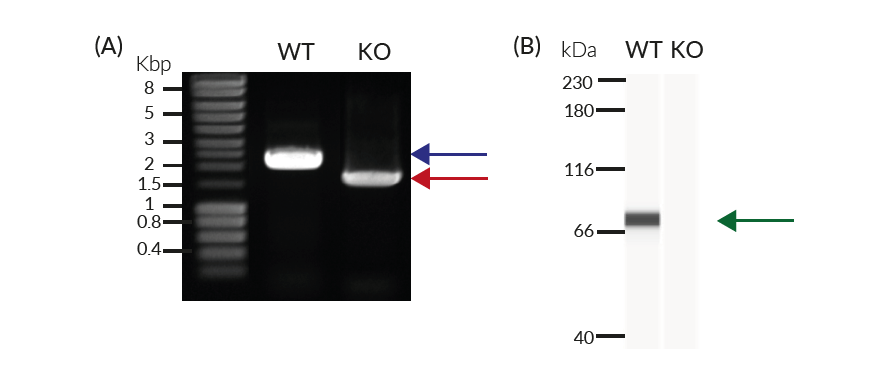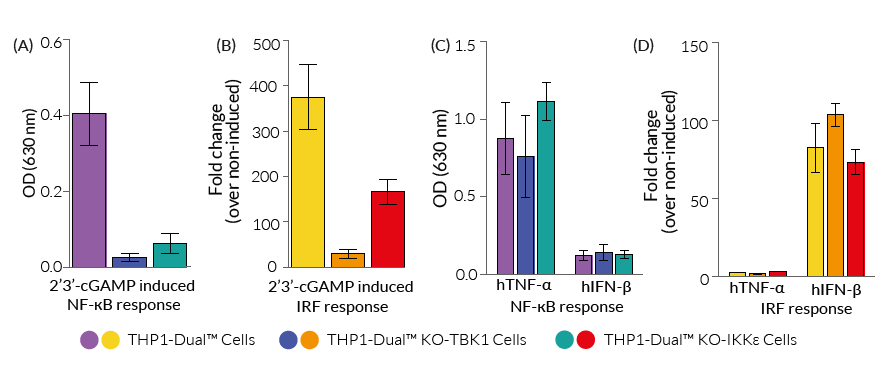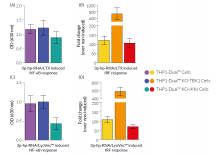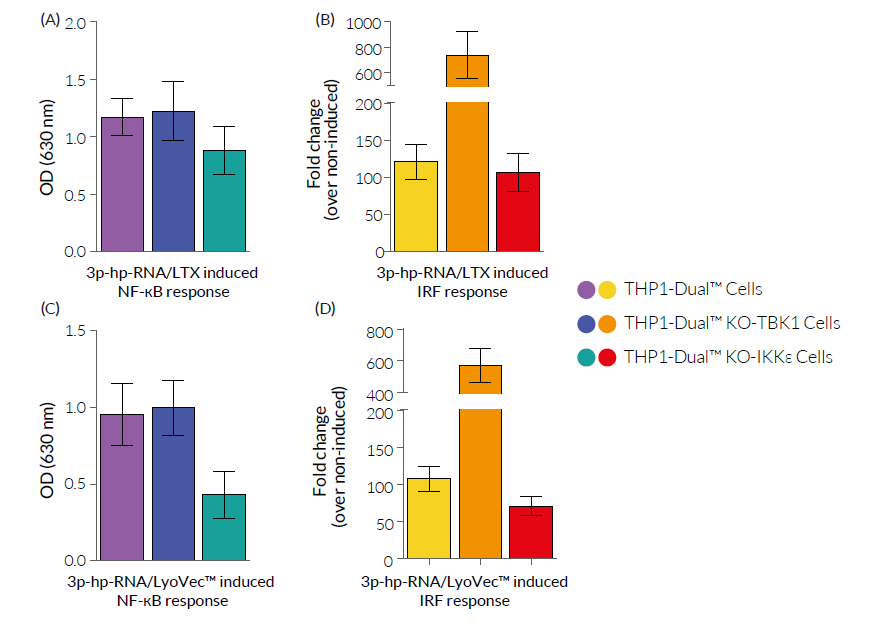IKK epsilon KO Dual Reporter THP1 Cells
| Product | Unit size | Cat. code | Docs. | Qty. | Price | |
|---|---|---|---|---|---|---|
|
THP1-Dual™ KO-IKKε Cells IKKε Knockout - Human THP-1 Reporter Monocytes |
Show product |
3-7 x 10e6 cells |
thpd-koikke
|
|
IKKε knockout dual reporter monocytes
THP1-Dual™ KO-IKKε cells were generated from the THP1-Dual™ cell line, which is derived from the human THP-1 monocytic cell line, through the stable knockout of the IKKε gene. THP1-Dual™ KO-IKKε cells feature two reporters allowing the study of the IRF pathway, by monitoring the activity of an inducible secreted Lucia luciferase, and the NF-κB pathway by monitoring the activity of an inducible SEAP (secreted embryonic alkaline phosphatase). Lucia luciferase and SEAP activities are readily assessable in the supernatant using QUANTI-Luc™ 4 Lucia/Gaussia and QUANTI-Blue™ Solution detection reagents, respectively.
IKK-related kinases IκB kinase ε (IKKε), also known as IKK-inducible or IKK-i, is an IKK-related kinase. IKKε is highly similar to the other reported IKK-related kinase, TANK binding kinase 1 (TBK1), and both play an essential role in innate immune responses. Notably, their roles and signaling pathways are highly intertwined (i.e. IKKε/TBK1), thus there remain many uncertainties about the individual function of these kinases [1-3]. Therefore, a comparison between THP1‑Dual™ KO‑IKKε and InvivoGen's THP1-Dual™ KO-TBK1 cells allows both overlap and differences in signaling functions between IKKε and TBK1 to be fully elucidated (see figures).
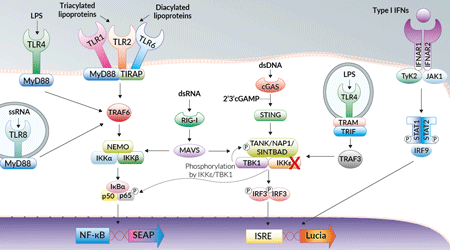
NF-κB and IRF signaling pathways in THP1-Dual™ KO-IKKε cells
Key Features:
- Verified knockout of the IKKε gene (PCR, DNA sequencing, Western blot, and functional assays)
- Functionally validated with a selection of PRR ligands and cytokines
- Readily assessable Lucia luciferase and SEAP reporter activities
- The stability for 20 passages, following thawing, has been verified
- Guaranteed mycoplasma-free
Applications:
- Defining the role of IKKε in PRR-induced signaling, or related cell signaling pathways
- Highlighting possible overlap and/or differences between IKKε and TBK1 signaling functions (see figures)
- Developing novel IKKε specific inhibitors
References:
1. Chau, T.L. et al. 2008. Are the IKKs and IKK-related kinases TBK1 and IKK-epsilon similarly activated? Trends Biochem Sci 33, 171-180.
2. Clement, J.F. et al. 2008. The IKK-related kinases: from innate immunity to oncogenesis. Cell Res 18, 889-899.
3. Verhelst, K. et al. 2013. IkappaB kinase epsilon (IKKepsilon): a therapeutic target in inflammation and cancer. Biochem Pharmacol 85, 873-880.
Specifications
Antibiotic resistance: Blasticidin and Zeocin®
Growth medium: RPMI 1640, 2 mM L-glutamine, 25 mM HEPES, 10% (v/v) fetal bovine serum (FBS), 100 U/ml penicillin, 100 µg/ml streptomycin, 100 µg/ml Normocin™
Quality Control:
- Biallelic IKKε knockout has been verified by PCR, DNA sequencing, and functional assays.
- The stability for 20 passages, following thawing, has been verified.
- These cells are guaranteed mycoplasma-free.
This product is covered by a Limited Use License (See Terms and Conditions).
Back to the topContents
- 3-7 x 106 THP1-Dual™ KO-IKKε cells in a cryovial or shipping flask
- 1 ml of Normocin™ (50 mg/ml). Normocin™ is a formulation of three antibiotics active against mycoplasmas, bacteria, and fungi.
- 1 ml of Zeocin® (100 mg/ml)
- 1 ml of Blasticidin (10 mg/ml)
- 1 tube of QUANTI-Luc™ 4 Reagent, a Lucia luciferase detection reagent (sufficient to prepare 25 ml)
- 1 ml of QB reagent and 1 ml of QB buffer (sufficient to prepare 100 ml of QUANTI-Blue™ Solution, a SEAP detection reagent)
![]() Shipped on dry ice (Europe, USA, Canada and some areas in Asia)
Shipped on dry ice (Europe, USA, Canada and some areas in Asia)
Details
IKKε Background
‘IKK-related kinases IκB kinase ε’ (IKKɛ), also known as IKK-inducible or IKK-i, is an IKK-related kinase. IKKɛ is highly similar to the other reported IKK-related kinase, TANK binding kinase 1 (TBK1), and both play an essential role in the innate immune response to bacterial and viral pathogens. Notably, their roles and signaling pathways are highly intertwined (i.e. IKKɛ/TBK1), thus there remain many uncertainties about their individual functions [1-3]. However, it is clear that they act downstream of a number of pattern recognition receptors (PRRs) such as the DNA-sensing cGAS, the RNA‑sensing RIG-I, as well as TLRs (e.g. TLR3 & TLR4). Ultimately, the stimulation of these PRRs activates IKKɛ/TBK1 promoting the induction of pro-inflammatory cytokines and interferons (IFNs) through the phosphorylation of NF-ĸB (i.e.p65) or interferon regulatory factors (IRF3 and IRF7), respectively [1, 3]. Activation of IKKɛ/TBK1 requires the binding of different scaffold proteins (TANK, NAP1, SINTBAD), which allow them to mediate their various phosphorylation activities [1, 3]. Interestingly, studies focusing on IKKɛ in particular, highlight an important role in the development of inflammatory diseases (e.g. Rheumatoid arthritis) [3]. Furthermore, IKKɛ is considered an oncogene due to its implication in multiple cancers [2, 3]. Thus, IKKɛ is considered a potential therapeutic target in the clinic.
References:
1. Chau, T.L. et al. 2008. Are the IKKs and IKK-related kinases TBK1 and IKK-epsilon similarly activated? Trends Biochem Sci 33, 171-180.
2. Clement, J.F. et al. 2008. The IKK-related kinases: from innate immunity to oncogenesis. Cell Res 18, 889-899.
3. Verhelst, K. et al. 2013. IkappaB kinase epsilon (IKKepsilon): a therapeutic target in inflammation and cancer. Biochem Pharmacol 85, 873-880.






